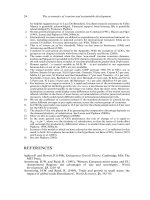THE ECONOMICS OF MONEY,BANKING, AND FINANCIAL MARKETS 378
Bạn đang xem bản rút gọn của tài liệu. Xem và tải ngay bản đầy đủ của tài liệu tại đây (36.85 KB, 1 trang )
CHAPTER 14
Risk Management with
Financial Derivatives
LE A RNI NG OB J ECTI VES
After studying this chapter you should be able to
1. distinguish among forwards, futures, options, swaps, and credit derivatives
2. discuss the success of the financial derivatives market
3. explain how managers of financial institutions use financial derivatives to manage
interest-rate and foreign exchange risk
4. outline the dangers of derivatives
PRE VI EW
Starting in the 1970s and increasingly in the 1980s and 1990s, the world became
a riskier place for financial institutions. Swings in interest rates widened, and
the bond and stock markets went through some episodes of increased volatility. As a result of these developments, managers of financial institutions have
become more concerned with reducing the risk their institutions face. Given the
greater demand for risk reduction, the process of financial innovation came to
the rescue by producing new assets that help financial institution managers
manage risk better. These assets, called financial derivatives, have payoffs that
are linked to previously issued securities and are extremely useful risk reduction tools.
In this chapter we look at the most important financial derivatives that managers
of financial institutions use to reduce risk: forward contracts, financial futures,
options, and swaps. We examine not only how markets for each of these financial
derivatives work but also how each can be used by financial institution managers
to reduce risk. We also study financial derivatives because they have become an
important source of profits for financial institutions, particularly larger banks.
HED GI N G
Financial derivatives are so effective in reducing risk because they enable financial
institutions to hedge, that is, engage in a financial transaction that reduces or eliminates risk. When a financial institution has bought an asset, it is said to have taken
a long position, and this exposes the institution to risk if the returns on the asset
are uncertain. On the other hand, if it has sold an asset that it has agreed to deliver
to another party at a future date, it is said to have taken a short position, and this
can also expose the institution to risk. Financial derivatives can be used to reduce
risk by invoking the following basic principle of hedging: Hedging risk involves
engaging in a financial transaction that offsets a long position by taking an
346









